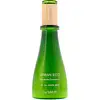What's inside
What's inside
 Key Ingredients
Key Ingredients

No key ingredients
 Benefits
Benefits

 Concerns
Concerns

 Ingredients Side-by-side
Ingredients Side-by-side

Water
Skin ConditioningCoco-Caprylate/Caprate
EmollientEthyl Macadamiate
Skin ConditioningGlycerin
HumectantC10-18 Triglycerides
EmollientPropanediol
SolventPolyglyceryl-6 Distearate
EmulsifyingBisabolol
MaskingAllantoin
Skin ConditioningGlycereth-26
HumectantCopernicia Cerifera Wax Extract
Simmondsia Chinensis Seed Oil
EmollientRice Bran Oil Polyglyceryl-3 Esters
EmulsifyingSclerotium Gum
Emulsion StabilisingIsosorbide Dicaprylate
Skin ConditioningZinc Hydrolyzed Hyaluronate
HumectantLinoleic Acid
CleansingLinolenic Acid
CleansingSqualene
EmollientMorinda Citrifolia Callus Culture Lysate
Skin ConditioningPotassium Cetyl Phosphate
EmulsifyingHelianthus Annuus Seed Oil
EmollientTocopherol
AntioxidantCitric Acid
BufferingBeta-Sitosterol
Emulsion StabilisingPhosphoric Acid
BufferingMalic Acid
BufferingEthylhexylglycerin
Skin ConditioningPhenoxyethanol
PreservativeWater, Coco-Caprylate/Caprate, Ethyl Macadamiate, Glycerin, C10-18 Triglycerides, Propanediol, Polyglyceryl-6 Distearate, Bisabolol, Allantoin, Glycereth-26, Copernicia Cerifera Wax Extract, Simmondsia Chinensis Seed Oil, Rice Bran Oil Polyglyceryl-3 Esters, Sclerotium Gum, Isosorbide Dicaprylate, Zinc Hydrolyzed Hyaluronate, Linoleic Acid, Linolenic Acid, Squalene, Morinda Citrifolia Callus Culture Lysate, Potassium Cetyl Phosphate, Helianthus Annuus Seed Oil, Tocopherol, Citric Acid, Beta-Sitosterol, Phosphoric Acid, Malic Acid, Ethylhexylglycerin, Phenoxyethanol
Phormium Tenax Extract
Skin ConditioningButylene Glycol
HumectantGlycerin
HumectantMethyl Gluceth-10
EmulsifyingDimethicone
EmollientDimethiconol
EmollientGlyceryl Acrylate/Acrylic Acid Copolymer
HumectantCetearyl Olivate
Sorbitan Olivate
EmulsifyingCyclopentasiloxane
EmollientCyclohexasiloxane
EmollientPolyacrylamide
C13-14 Isoparaffin
EmollientLaureth-7
EmulsifyingPEG-60 Glyceryl Isostearate
Portulaca Oleracea Extract
Skin ConditioningAcrylates/C10-30 Alkyl Acrylate Crosspolymer
Emulsion StabilisingPotassium Hydroxide
BufferingPhenoxyethanol
PreservativeChlorphenesin
AntimicrobialParfum
MaskingDisodium EDTA
Honey
HumectantCalendula Officinalis Flower Water
MaskingPotassium Sorbate
PreservativeSodium Benzoate
MaskingCitric Acid
BufferingEchinacea Angustifolia Root Cell Culture Extract
Skin Conditioning1,2-Hexanediol
Skin ConditioningPhormium Tenax Extract, Butylene Glycol, Glycerin, Methyl Gluceth-10, Dimethicone, Dimethiconol, Glyceryl Acrylate/Acrylic Acid Copolymer, Cetearyl Olivate, Sorbitan Olivate, Cyclopentasiloxane, Cyclohexasiloxane, Polyacrylamide, C13-14 Isoparaffin, Laureth-7, PEG-60 Glyceryl Isostearate, Portulaca Oleracea Extract, Acrylates/C10-30 Alkyl Acrylate Crosspolymer, Potassium Hydroxide, Phenoxyethanol, Chlorphenesin, Parfum, Disodium EDTA, Honey, Calendula Officinalis Flower Water, Potassium Sorbate, Sodium Benzoate, Citric Acid, Echinacea Angustifolia Root Cell Culture Extract, 1,2-Hexanediol
Ingredients Explained
These ingredients are found in both products.
Ingredients higher up in an ingredient list are typically present in a larger amount.
Citric Acid is an alpha hydroxy acid (AHA) naturally found in citrus fruits like oranges, lemons, and limes.
Like other AHAs, citric acid can exfoliate skin by breaking down the bonds that hold dead skin cells together. This helps reveal smoother and brighter skin underneath.
However, this exfoliating effect only happens at high concentrations (20%) which can be hard to find in cosmetic products.
Due to this, citric acid is usually included in small amounts as a pH adjuster. This helps keep products slightly more acidic and compatible with skin's natural pH.
In skincare formulas, citric acid can:
While it can provide some skin benefits, research shows lactic acid and glycolic acid are generally more effective and less irritating exfoliants.
Most citric acid used in skincare today is made by fermenting sugars (usually from molasses). This synthetic version is identical to the natural citrus form but easier to stabilize and use in formulations.
Read more about some other popular AHA's here:
Learn more about Citric AcidGlycerin is already naturally found in your skin. It helps moisturize and protect your skin.
A study from 2016 found glycerin to be more effective as a humectant than AHAs and hyaluronic acid.
As a humectant, it helps the skin stay hydrated by pulling moisture to your skin. The low molecular weight of glycerin allows it to pull moisture into the deeper layers of your skin.
Hydrated skin improves your skin barrier; Your skin barrier helps protect against irritants and bacteria.
Glycerin has also been found to have antimicrobial and antiviral properties. Due to these properties, glycerin is often used in wound and burn treatments.
In cosmetics, glycerin is usually derived from plants such as soybean or palm. However, it can also be sourced from animals, such as tallow or animal fat.
This ingredient is organic, colorless, odorless, and non-toxic.
Glycerin is the name for this ingredient in American English. British English uses Glycerol/Glycerine.
Learn more about GlycerinPhenoxyethanol is a preservative that has germicide, antimicrobial, and aromatic properties. Studies show that phenoxyethanol can prevent microbial growth. By itself, it has a scent that is similar to that of a rose.
It's often used in formulations along with Caprylyl Glycol to preserve the shelf life of products.